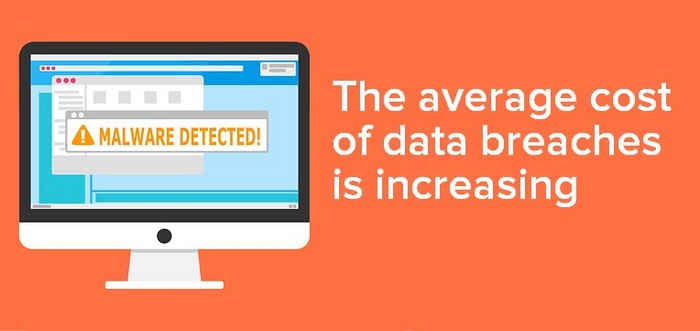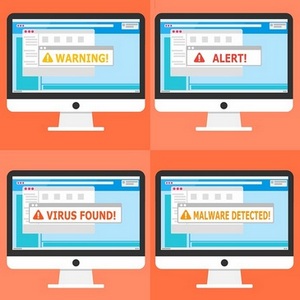In this article, we discuss the growing threat from cybercriminals and discuss some of the major security stats that you should know.

Security Stats You Should Know – Insider Threat Detection for 2020
They say that every successful individual or business must adhere to the rule of 5 Ps:
Proper Preparation Prevents Poor Performance.
In our case, the Performance part can be replaced with Protection, cyber protection to be precise.
In order to protect yourselves properly for the future cyber assaults, you have to be aware of the top stats that form the agenda in the cyber world.
The overall number of data breaches increases at a staggering pace
2018 was a very turbulent year in terms of the overall volume of registered data breaches throughout the world.
The news about Facebooks massive data breach scandal has been shaking the entire globe on numerous occasions throughout the year.
Just a few days ago, CNN reported that the EU regulator could impose enormous fines on Facebook, which may amount to several billion USD, for allowing cybercriminals to breach their databases and steal personal information of almost 7 million users.
And that case is just a big drop in the ocean.
According to the Gemalto’s Breach Level Index, during the first six months of 2018, there were almost a thousand reported data breaches which resulted in more than 4.5 billion data records being stolen or corrupted.
It is a mind-blowing 133% increase in contrast to the previous year.
These figures are so outrageous that they have to
- 65% of all breaches were carried out with the purpose of identity theft;
- 17% of attacks were made to gain unauthorized access to a personal or a company account;
- 13% were aimed at obtaining access to certain financial information like credit cards details, transaction history etc.;
- 56% of cyber attacks were caused by malicious outsiders;
- 34% of data breaches resulted from the common human mistake or an accidental loss of data.
Crypto mining is on the rise
The Comodo Cybersecurity Research Labs issues a report in which they stated that attacks associated with crypto mining, commonly known as crypto jacking, have to be given particular attention since this method virtual assault is gaining vast popularity and even ‘outperforms’ the attacks that are relying on the use of ransomware. Cryptojacking is a type of cyber attack which implies that perpetrators are hacking the victim’s computer.
They then use its computing power to generate (mine) cryptocurrencies.
Despite the fact that it takes only a few lines of properly written code to crypto jack someone’s computer, most antiviruses and firewalls are struggling with detecting the attempted or the ongoing crypto hacking in due time.
As the result, the cyber prey’s computer uses its computation capabilities to someone else’s benefit.
In the first few months of 2018, Comodo registered 30 million data breach incidents which were associated with crypto jacking, a solid 10% out of the overall 300 million attacks registered by the company over the course of that period.
The browser-based crypto jacking is particularly popular these days with CoinHive being the most popular script utilized for that purpose.
Adguard reports that 95% of all crypto jacked websites had this script covertly imprinted in their codes.
Here is an interesting fact.
Earlier this year, Japanese authorities arrested and sentenced a crypto jacker who attacked the network of a large corporation and contaminated it with a crypto mining script.
The failed hacker was sentenced to a year in a correction facility and a sizeable fine.

The average cost of data breaches is increasing
Ponemon Institute published a study called The Cost of Data Breach in 2018 where they have specifically pointed out that the overall cost, as well as the cost per company, of a data breach, have increased over the course of 2018, and this tendency will continue in 2019/20. According to Ponemon’s stats:
The average cost of a data breach for any given company in the world amounts to $3.86 million;
In case of companies that conduct business in the US, this cost is even higher – $7.91 million/
According to Security Intelligence, the average cost of a data breach may vary, depending on the number of records that had been either corrupted or stolen.
The breach that impacted 10 thousand or fewer records might have caused around $2 million on average in 2018, whilst the breach that managed to hit 50+ thousand records would cost the company $7 million.
The breach of an enormous scale, like the one that happened at Facebook, when 50 million or more records are being compromised would cost the company almost half a billion USD.
According to the IBM report, the median cost for each successful cyber attack in 2018 has increased by 6,4% (with the average per capita cost at 4.8%) and it will definitely continue to rise during 2019/20.
The cost of each data breach is also in direct correlation with the time required to detect the breach and eliminate its disruptive effect.
The company can save up to $14 per record if they react to a detected data security breach in a timely manner.
However, the same report states that it takes an average of 197 days for a company to detect the data breach and the additional 19 to 40 days to mitigate all negative effects.
Given that the hacking techniques are getting more sophisticated and less detectable, it is no wonder that it takes an incident response team more time to discover and eradicate the threat which results in larger financial losses.
Join the conversation - Security Stats You Should Know - Insider Threat Detection for 2020 Click To TweetEmail hacking is still a burning issue
This year’s Breach Investigation report by Verizon revealed a shocking statistics that 92% of all malware is still being dispersed among victims through such an archaic channel as emails.
The malefactors are still using the good old method known as phishing attacks. It’s quite unbelievable but 4% of employees still succumb to phishing campaigns despite the numerous educational seminars and training that take place in most companies.
Perhaps the non-responsiveness to training should be blamed for this because the Verizon report says that the same 4% of unsavvy employees are most likely to repeat their mistake of buying into the phishing campaign.
Despite that number being small, we are well aware of the fact that a single successful cyber attack may have a devastating impact on the integrity of consumer and corporate data
Fileless attacks are gaining power
The fileless attack is gradually becoming a notorious data breaching mechanism that’s been actively employed by hackers throughout the world.
A quick reminder:
A fileless attack (also known as a non-malware attack or zero-footprint attack) is a type of cyber assault that actually doesn’t involve the installation of any malicious software on a computer.
Such attacks usually can’t be detected by conventional firewalls or antiviruses.
It is an extremely threatening trend, which began in late 2017 and continued its upward move in 2018, for the companies that work with big databases because these strikes are virtually undetectable and untraceable. Moreover, they are frighteningly efficient.
According to the report published by Ponemon Institute, 77% of all impactful data breaches occurred due to fileless attacks.
The Q2 Treat report published a very reputable company MacAfee Labs states that the percentage of fileless attacks which resulted in data breaches of various scale has increased by 432% since 2017.
Moreover, the perpetrators are using more and more sophisticated techniques that involve launching the malevolent attacks directly from the memory, thus rendering nearly all antiviruses and other protective software obsolete.
No one so far has been capable of finding an efficient solution to this grave threat.
Therefore, it is highly likely that the number of cyber perpetrations for the purpose of data breaching via lifeless attacks will increase exponentially in 2019/20.
The half of data breaches will occur in the United States by 2023
According to the 2018 research that was conducted by Juniper Research, by 2023, the data center and businesses in the United States will become the primary victims of cybercriminals.
They estimate that, given the current rate of data theft and other malicious online activities which amounts to 12 billion stolen personal and business records, the US will be the most popular go-to place for online perpetrators.
They’ve calculated that in 2023 this country would have over 33 billion records stolen from data centres of various scale.
It is basically the downside of being the most developed country in the most because it means that it retains literally the biggest volume of corporate, as well as consumer, data in comparison with other prosperous countries which ultimately makes it the most appealing object for attacks.
Most organizations don’t believe in antiviruses’ ability to halt cyber threats
The hackers are getting more inventive and resourceful year after year which means that all conventional countermeasures are getting dated at an even quicker pace. Businesses no longer trust the usual solutions, like popular antiviruses, to protect their sensitive data from perpetrators.
The Ponemon Institute revealed that 69% of businesses have lost faith in their usual means of data protection because they are convinced that the current generation of antiviruses is ‘blind’ to the newly emerging threats.
Therefore, they are looking for the new towers of strength which usually come in the form of the new generation of antiviruses or the endpoint detection and response solutions, which serves as an additional layer to the overall data security architecture.
However, these security measures have some downsides which.
They are reflected in the significant increase in workload on the company’s security team as well as the additional expenditures on salaries and software maintenance.
However, there is employee monitoring software that is gaining a lot of traction.
It provides the means for managers to not only track the employees’ online activity but also block a potentially hazardous website that may contain phishing links.
This will allow for a better insider threat detection and prevention of possible data breaches.
In most cases, data thieves are financially motivated
The data thieves or cybercriminals, who are driven by some kind of ideology or moral principles are the exceptions to the rules.
The overwhelming majority of online outlaws have only financial motivation in mind.
The Verizon study shows that 76% of people who commit data breaches just want to squeeze some money from the user who was negligent towards data protection. The victim’s social status or his income level doesn’t really matter to the online crime figures. Interestingly, 77% of all cyber attack that involved data theft affected people with low to average income level.
The unprotectedness of a victim serves as a bigger allurement for perpetrators than his financial status.
However, it means that cyber villains give preference to an easy prey which they would still denude of money, no matter how small a sum.
The healthcare industry should expect the largest number of cyber attacks
The recent Symantec report revealed that the healthcare sector should be prepared for a massive wave of ransomware attacks, particularly the attacks that involve SamSam, the technique of targeted attack that usually includes brute-force tactics and exploits the weaknesses of the remote desk protocol.
The reason why hackers are particularly interested in the healthcare sector is due to the fact that it contains a lot of ultra-sensitive information.
The Health IT Security revealed the shocking security stats, according to which more than 4.4 million records have been compromised in the course of 117 data breaches in the healthcare industry only in the third quarter of 2018.
The institutions can’t cope with the task of auditing the access to the health data.
This means that this sector will remain under the threat of constant data breaches in 2019/20.

Security Stats You Should Know – Insider Threat Detection for 2019/20 – Takeaways
Familiarise yourself with the security stats in the reports that we have outlined and take the steps that you can to protect your business, your site and your online presence.
That’s all for now
If you have any questions then please leave them in the comment form below.
Make sure that you subscribe to the comments so that you are notified when I reply
Regards
Dexter
Related Articles
Cybersecurity Risk – What’s your strategy for Cybersecurity?
How to secure your WordPress site [Guide]
Social Media Monitoring Apps – Could They Help Create A More Productive And Happier You?











Bluetechno
That’s really interesting. At the end I think all the companies will try to create their own antiviruses depending on what they think they are more vulnerable to.
Bluetechno recently posted…Crypto Trading Cheat Sheet (2018)
maxcybersecurity
It’s a really great post. Every year cyber threats are increasing because its a new way of loot and extortion. Governments are taking this seriously and making the plan. But I think its a new boom of cybersecurity companies because the will launch better products. Thanks for your valuable data and other information.
maxcybersecurity recently posted…Why small business are not serious about their Cyber security
Ryan K Biddulph
All good to know Dexter. Just a bit of research helps you find the solution you need to cruise the web safely. A wee bit of homework does the trick.
Ryan K Biddulph recently posted…By: Ryan Biddulph
Sajid Hussain
It has become a must for e-commerce websites to have secure transactions. useful data
Hannah Lagdameo
This is a very informative write up. Everyone should read this for awareness. Thank you so much for sharing this.
Hannah Lagdameo recently posted…Creating a Secure Workplace with Security Systems in the Philippines
Jasweer
nice post. thanks for sharing
IT Security
When i am searching on google about it security then i am reached on your article amazing nice guide i would like to share this because its very hepful for me keep it up!
IT Security recently posted…Watch out – fake myGov tax refund email
ali
Hello,
It was a very nicely written article. I like to read it. It was totally informative and topic you covered here, I am totally agreed with you. I must say that I have learnt so many things from it.
Thank you for sharing this article. Keep writing. Thank you so much.
Neil Dimapilis
Thank you so much for sharing this with us, this is very helpful and very much appreciated
Lauren Smith
Thank you for this helpful insight! Based on the given numbers stated in this article, cyber threat keeps increasing that’s why companies should be always updated to become aware of these threats and can do something. If you’re looking for more helpful contents and threat detection tools, you may visit Guides for ThreatDetection.
Lauren Smith recently posted…How Cyber Attacks Make Life Difficult for Telcos
jNicholas
Everyone should read this for awareness. I agree with Proper Preparation Prevents Poor Performance.
jNicholas recently posted…6 Questions to Ask Security Solutions Vendors Who Claim They Use Artificial Intelligence